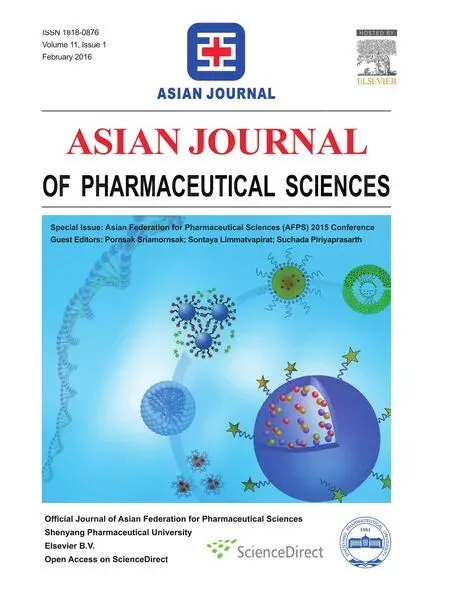Microwave technology enabled transdermal nanocarrier and drug delivery
aNon-Destructive Biomedical and Pharmaceutical Research Centre,iPROMISE,Universiti Teknologi MARA, Puncak Alam,Selangor 42300,Malaysia
bParticle Design Research Group,Faculty of Pharmacy,Universiti Teknologi MARA,Puncak Alam,Selangor 42300,Malaysia
Microwave technology enabled transdermal nanocarrier and drug delivery
Tin Wui Wonga,b,*
aNon-Destructive Biomedical and Pharmaceutical Research Centre,iPROMISE,Universiti Teknologi MARA, Puncak Alam,Selangor 42300,Malaysia
bParticle Design Research Group,Faculty of Pharmacy,Universiti Teknologi MARA,Puncak Alam,Selangor 42300,Malaysia
A R T I C L E I N F O
Article history:
Available online 23 November 2015
Microwave technology
Transdermal
Nanocarrier
Drug delivery
Transdermal drug delivery is impeded by the natural barrier of epidermis known as stratum corneum.This limits the route to transport of drugs with a log octanol–water partition coeffcient of 1 to 3,molecular weight of less than 500 Da and melting point of less than 200°C.Nanotechnology has received a widespread investigation as the nanocarriers are able to fuidize the stratum corneum as a function of size,shape, surface charges,and hydrophilicity–hydrophobicity balance, while delivering drugs across the skin barrier.This presentation provides an overview on the transdermal drug delivery performances of liposomes,ethosomes,transfersomes, niosomes,magnetosomes,oil-in-water nanoemulsions,waterin-oil nanoemulsions,bicontinuous nanoemulsions,covalently crosslinked polysaccharide nanoparticles,ionically crosslinked polysaccharide nanoparticles,polyelectrolyte coacervated nanoparticles and hydrophobically modifed polysaccharide nanoparticles with respect to their ability to fuse or fuidize lipid/protein/tight junction regimes of skin.Universal relationships of nanocarrier size,zeta potential and chemical composition on transdermal permeation characteristics of drugs will be discussed[1].
In recent years,the microwave is found to be able to exert spacing of lipid architecture of stratum corneum into structureless domains and promote transdermal drug delivery[2,3]. It is able to act as a radiation permeation enhancer and work synergistically with the chemical permeation enhancer such as oleic acid to promote transdermal drug delivery.The performance of microwave as transdermal permeation enhancer is challenged by the type of dosage form applied on skin,where the recent fndings indicate that polymeric macromolecules from semisolid samples can act as a binder to the intercellular spaces created by microwave,thereby leading to reduced drug permeation.The presentation will highlight the latest fndings of microwave enabling transdermal nanocarrier and drugdelivery.Microwave is reckoned to be the next generation technology in transdermal delivery.More research and development works are required to examine its worth in drug delivery with respect to the advances of nanotechnology and biologics.
Acknowledgement
The author acknowledges the fnancial support of UiTM, Malaysia(0141903).
R E F E R E N C E S
[1]Rahim Khan N,Harun MS,Nawaz A,et al.Nanocarriers and their actions to improve skin permeability and transdermal drug delivery.Curr Pharm Des 2015;21(20):2848–2866.
[2]Wong TW.Electrical,magnetic,photomechanical and cavitational waves to overcome skin barrier for transdermal drug delivery.J Control Release 2014;193:257–269.
[3]Wong TW,Anuar NK.Physicochemical modulation of skin barrier by microwave for transdermal drug delivery.Pharm Res 2013;30:90–103.
*E-mail address:wongtinwui@salam.uitm.edu.my;wongtinwui@yahoo.com.
Peer review under responsibility of Shenyang Pharmaceutical University.
http://dx.doi.org/10.1016/j.ajps.2015.10.029
1818-0876/?2016 The Author.Production and hosting by Elsevier B.V.on behalf of Shenyang Pharmaceutical University.This is an open access article under the CC BY-NC-ND license(http://creativecommons.org/licenses/by-nc-nd/4.0/).
 Asian Journal of Pharmacentical Sciences2016年1期
Asian Journal of Pharmacentical Sciences2016年1期
- Asian Journal of Pharmacentical Sciences的其它文章
- Determination of the antidepressant effect of mirtazapine augmented with caffeine using Swiss-albino mice
- Photosafety testing of dermally-applied chemicals based on photochemical and cassette-dosing pharmacokinetic data
- Biopharmaceutics classifcation system(BCS)-based biowaiver for immediate release solid oral dosage forms of moxifoxacin hydrochloride (Moxifox GPO)manufactured by the Government Pharmaceutical Organization(GPO)
- Bioequivalence study of abacavir/lamivudine (600/300-mg)tablets in healthy Thai volunteers under fasting conditions
- Evaluation of cytotoxic and infammatory properties of clove oil microemulsion in mice
- Analytical method development of pregabalin and related substances in extended release tablets containing polyethylene oxide
